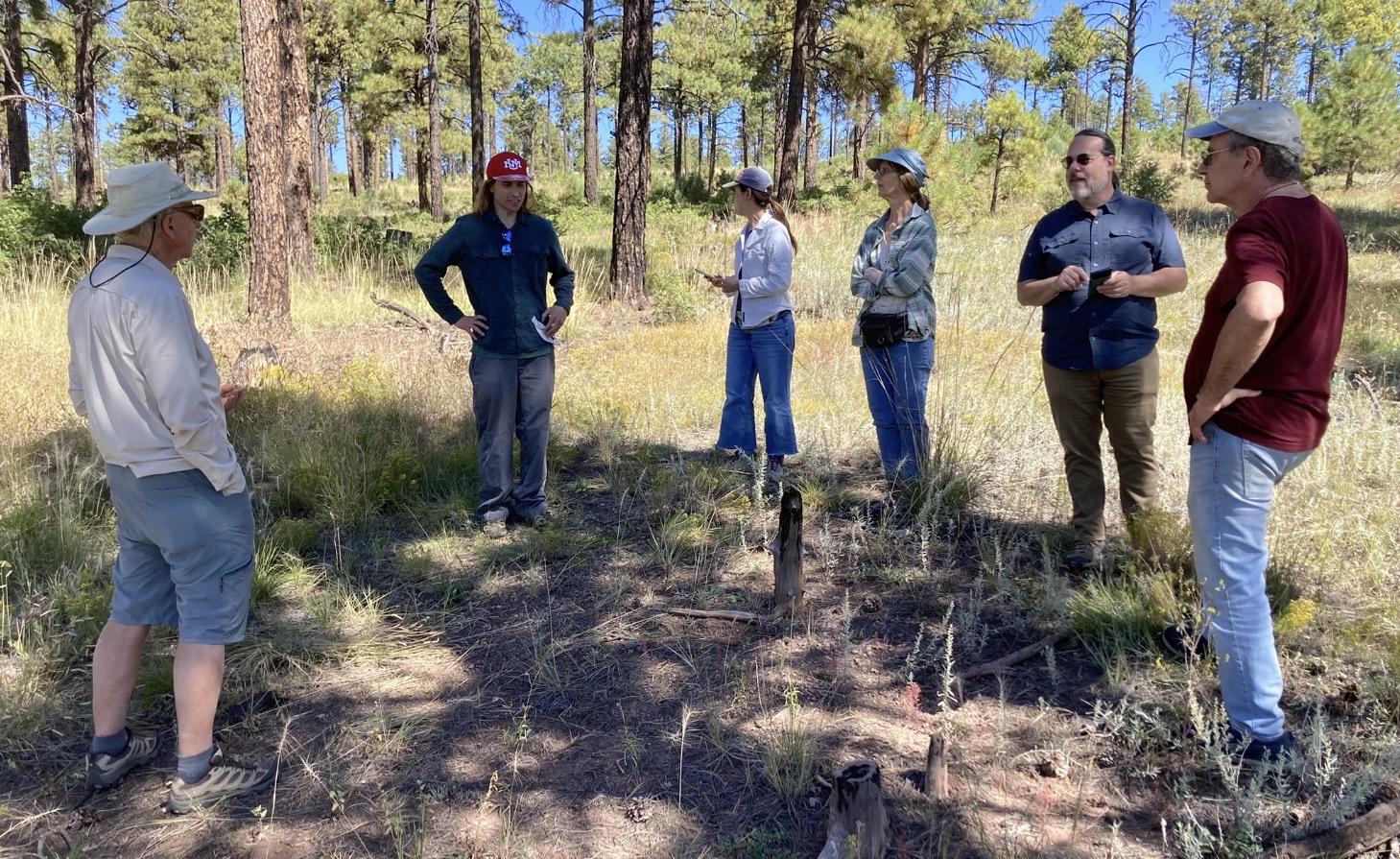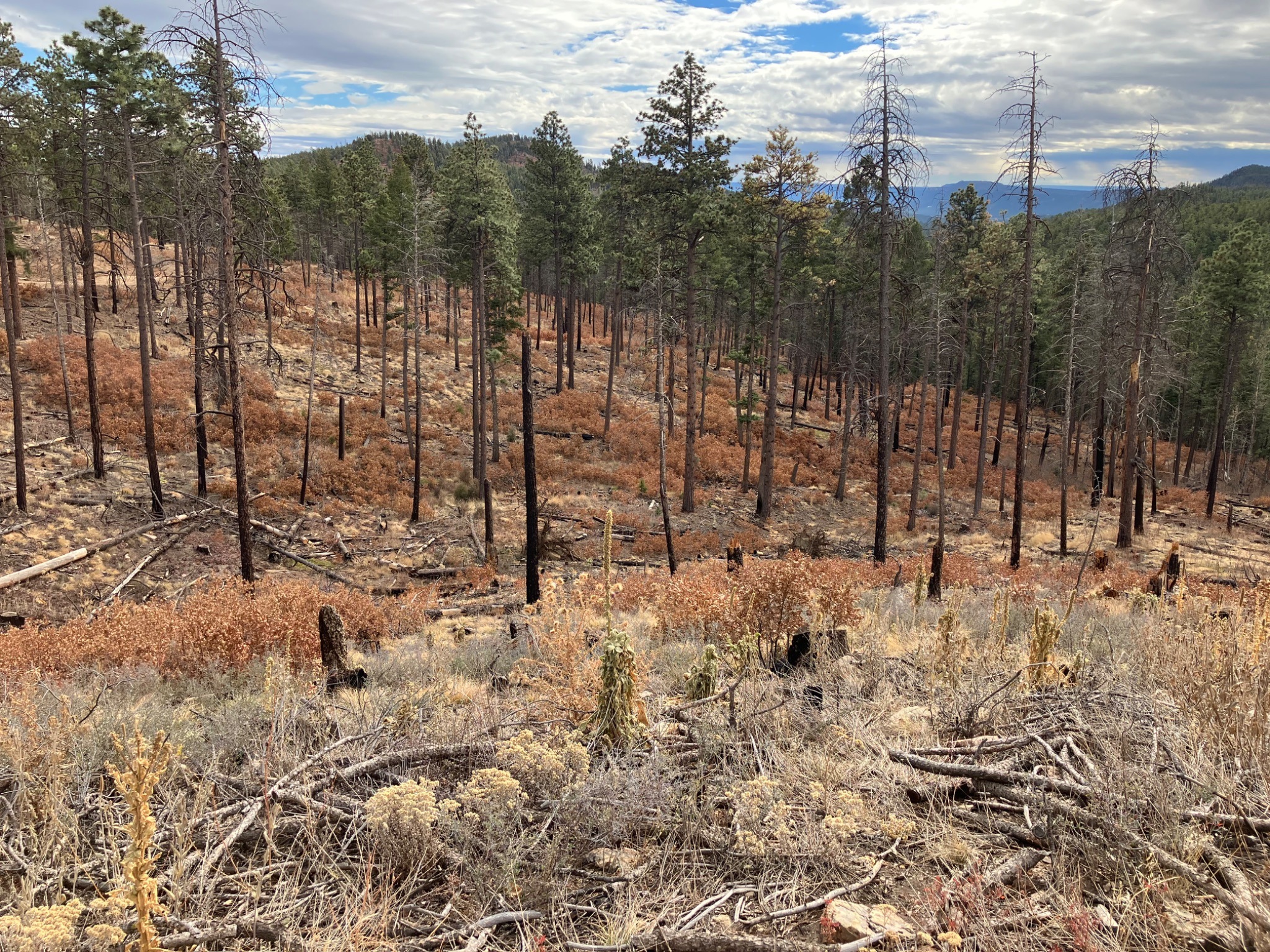Rethinking Dry Forest Management in a Warming Climate

La Cueva, Santa Fe National Forest. From left to right: Sam Hitt, president of the Santa Fe Forest Coalition, Joey Smallwood M.S., environmental studies and GIS, Cristina Salvador M.S., plant ecologist at the Santa Fe Botanical Garden, Sarah Hyden, co-founder and director of The Forest Advocate, Adam Rissien M.S., environmental studies, ReWilding Manager at WildEarth Guardians, Dominick DellaSala, Ph.D., Chief Scientist at Wild Heritage. Photo: Jonathan Glass, Public Journal and co-founder of The Forest Advocate.
Recently, a group of scientists and conservation organization representatives came together for a series of field days to survey and discuss current ecological conditions on the east side of the Santa Fe National Forest. We, along with others not present on these field days, are planning on creating a conservation alternative to the Santa Fe Mountains Landscape Resiliency Project, an already-in-progress US Forest Service project primarily focused on aggressive tree cutting and prescribed fire across large sections of forest. The Forest Service’s stated purpose of the Santa Fe Mountains Project is to reduce fire risk and to restore forest “health” and “resilience,” but past cutting/burning projects have caused severe ecological damage, and the potential fire mitigation effects are questionable at best. The project is just beginning, and not many acres have been treated so far. It is still possible to alter the course of this project, and to design a holistic alternative that truly protects and restores this unique and beautiful forest that is in the process of climate transition.
The conservation alternative will also be a template for conservation projects in dry forests across the West. It will focus on the retention of water in the ecosystem through a variety of strategies, while greatly decreasing treatments that overly open up and dry out forested landscapes.
Over three days, we viewed relatively undisturbed forest, cutting and burning treatments, and forest burned from wildfire. Various types of disturbances have seriously impacted the Santa Fe Mountains ecosystem. In one area, cutting and burning treatments from 15 years ago have precipitated a dense growth of Gambel oak that is crowding out much of the pre-existing natural understory. Some of the remaining ponderosa pines in the Gambel oak thickets are turning brown, and some are dying. In the Santa Fe watershed, which over two decades ago was aggressively cut and subsequently burned twice, some hillsides appear largely barren. These areas have little understory, little biodiversity, and only similar-size seemingly low-vitality trees with not much but grasses in between.
We observed a burn area from a fire that occurred 22 years ago. We were unable to see any signs of conifer regeneration in the high severity burn area, although there are plans to investigate this further. There also appeared to be little conifer regeneration in a moderate severity section of the same fire.
Although we were already generally aware of conditions in the Santa Fe National Forest, this overview was eye-opening and alarming. Natural disturbances to an ecosystem are normal, and often beneficial, but many of these disturbances are human-caused, and the disturbed areas of our forest appear to be going onto a concerning trajectory. Wetter forests are generally still capable of substantial regeneration after disturbances, but in these dry forests, some areas appear to be type converting into shrublands after cutting and burning treatments, and possibly also after moderate and high severity fire. However, in some cases conifer regeneration in high severity burn areas can naturally take up to two decades or more in dry Southwestern forests. The influence of the combination of a rapidly changing climate and Forest Service treatments could be speeding up vegetation type shifts.
The forests of the Santa Fe Mountains appear to be in the beginning stages of advancing climate impacts. It’s a challenge to develop strategies to protect and restore forests in this situation. The agency approaches are not working – widespread cutting and overly frequent burning are creating landscapes that no longer even resemble forests, but are instead overly-open, dried-out, weed infested landscapes with little natural understory and widely spaced trees prone to blow over. Our conservation alternative will be a call to develop a new forest management paradigm for such dry forests as quickly as possible.
There may be some level of much lighter fuels reduction treatments that these forests can tolerate, but exactly what may work is presently unknown. Recent Forest Service cutting treatments have left somewhat greater residual tree densities than some of the treatments from over a decade ago, but it is unknown if that is enough to avoid serious adverse impacts, especially to forest soils and natural understories. After cutting trees, the trunks and branches are piled and burned, and pile burn scars remain for decades. Pile burning causes such high intensity heat that the natural understory does not tend to come back, and invasive weeds often appear. The Forest Service plans to cut approximately 18,000 acres during the 10-year Santa Fe Mountains Project, and if there are 20 burn piles per acre, they would be burning in the neighborhood of 360,000 piles. That would have a tremendous impact on already dried out soils.
Not nearly enough local research exists on the impacts of aggressive cutting and burning treatments on dry forest understories. It is not clear what the impacts of such treatments are on the mycorrhizal fungal networks that help to retain soil moisture. In the Santa Fe Mountains Project analysis, no references are provided for the composition of historical understories, nor is the composition of current relatively undisturbed local understories identified. Unfortunately, completely undisturbed understories rarely exist in the Santa Fe National Forest due to ongoing cattle grazing, which is permitted in most national forests across the West.
Due to the need for increased knowledge about what is happening to the ecology of this dry forest, and what conditions are optimal to preserve sections that still have adequate ecosystem function, preliminary research studies are in planning or in progress. Dr. Dominick DellaSala et al. have just completed an ecoregional conservation assessment for the southern Rockies, with a focus on the Santa Fe National Forest, which will be an underpinning of the Santa Fe Mountains conservation alternative. The authors found that the Santa Fe National Forest is lagging in terms of multiple conservation goals, and that forests far from communities are receiving treatments which neither provide community protection from wildfire nor appear to have a net ecological benefit. The assessment also projects climate change impacts on the region.
While Dr. DellaSala was in Santa Fe for the field days, he gave a very well-received talk about the ecoregional conservation assessment, at the invitation of the Santa Fe Botanical Garden. He described the impacts of overly aggressive treatments on the dry Santa Fe Mountains forest ecosystem, which he said is not forest restoration, but instead is forest degradation. He pointed out that there are no understory reference conditions, which are necessary for restoration.
This overview of Santa Fe National Forest conditions has coalesced my own views of what may be occurring in the SFNF, and what are the fundamental needs to begin to address regarding forest management in the area. My impressions are:
+ Aggressive cutting and burning are causing severe impacts to forest understories, and it’s hard to see how they can subsequently be restored to a more natural landscape.
+ Moderate to high severity fire could possibly cause ecosystem type conversion in this dry forest. More research is needed regarding post-fire conifer regeneration after high severity fire in this area.
+ Our challenge is to balance the important role of fire on our landscapes vs. possibly increasing impacts of fire on our landscapes.
+ In areas where water retention has been increased by holistic restoration projects, or is already adequate, managing lightning ignitions under safe conditions for ecosystem benefits may be a reasonable option. Limited and carefully implemented prescribed burns may be necessary near communities where managed wildfire may not be acceptable to community members, but the optimal conditions for such burns still need to be determined.
+ Most restoration in this area should be focused on retaining moisture in the ecosystem, instead of drying it out further by aggressive cutting which dries out soils and understory vegetation, and over-burning which suppresses the natural understory. Higher vegetation moisture content reduces flammability. The focus of treatments should be primarily on maintaining ecosystem integrity and function; these forests need approaches that are different from extensive vegetation removal in an attempt to mitigate fire behavior and to match forest structure to agency estimates of historical forest structure.
+ Much more research is needed concerning the impacts of any kinds of disturbances on soils, understory vegetation, and conifer regeneration. It is necessary to have relatively intact understory references in order to consider desired understory conditions.
+ Serious consideration should be given to the effects of forest cutting and burning treatments on mycorrhizal fungi, and maintaining viable mycorrhizal fungi in soils should be a focus.
+ Consideration should be given to determining optimal times and methods in which to implement any potential cutting or burning treatments. Such treatments, if they occur, should be well-considered, strategic, limited, light-handed and include strategies to maintain a relatively natural understory.
+ More attention should be given to modifying human behaviors in forests that can cause fires to ignite.
+ An environmental impact statement should be completed for the Santa Fe Mountains Project to provide a framework in which to do a thorough analysis of the effects of disturbances on this ecologically precarious project landscape, given that effects of disturbances are very different than from even a decade or two ago. All of the adverse impacts of the recent two decades of fuels treatments must be taken into account, including the burning of 387,000 acres of forest from three separate SFNF escaped prescribed burns in 2022.
+ A moratorium on most cutting and burning treatments in the Santa Fe National Forest should be considered until the impacts of treatments during the rapid climate transition have been fully analyzed, and until updated and holistic forest management strategies are developed.

Hillside in Black Canyon, cut in the early 2000’s and burned twice. Photo: Sarah Hyden.

Old Growth in Pacheco Canyon, untreated. Photo: Sarah Hyden.

Santa Fe Municipal Watershed north of the Canada de los Alamos Forest, cut in the early 2000’s and burned twice. Photo: Sarah Hyden.

Gambel oak overgrowth in La Cueva canyon, cut 15 years ago and subsequently burned. It is a fuel break, but it was cut to a similar density of other projects of that time. This photo is from October of 2023, and conditions have not appreciably changed. The Gambel oak overgrowth extends throughout most of the treated area. Photo: Sarah Hyden.

2002 Dalton Fire high severity burn area, next to unburned forest. Little conifer regeneration can be seen. Photo: Sarah Hyden.

Map of field trip sites visited. Blue perimeter represents the Santa Fe Municipal Watershed boundary. Map composite by Jonathan Glass, Public Journal. Base map: ESRI National Geographic.
